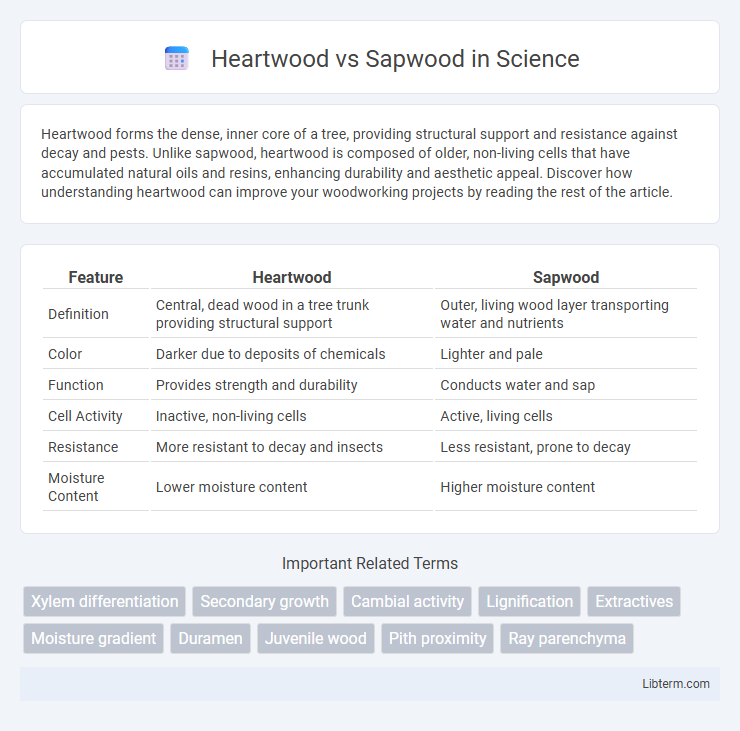Heartwood forms the dense, inner core of a tree, providing structural support and resistance against decay and pests. Unlike sapwood, heartwood is composed of older, non-living cells that have accumulated natural oils and resins, enhancing durability and aesthetic appeal. Discover how understanding heartwood can improve your woodworking projects by reading the rest of the article.
Table of Comparison
| Feature | Heartwood | Sapwood |
|---|---|---|
| Definition | Central, dead wood in a tree trunk providing structural support | Outer, living wood layer transporting water and nutrients |
| Color | Darker due to deposits of chemicals | Lighter and pale |
| Function | Provides strength and durability | Conducts water and sap |
| Cell Activity | Inactive, non-living cells | Active, living cells |
| Resistance | More resistant to decay and insects | Less resistant, prone to decay |
| Moisture Content | Lower moisture content | Higher moisture content |
Introduction to Heartwood and Sapwood
Heartwood forms the dense, central core of a tree trunk, characterized by its darker color and higher resistance to decay due to accumulated antimicrobial compounds. Sapwood surrounds the heartwood and consists of younger, lighter-colored wood responsible for transporting water and nutrients from the roots to the leaves. The distinction between heartwood and sapwood impacts wood durability, strength, and usability in construction and furniture making.
Definition of Heartwood
Heartwood is the central, non-living part of a tree trunk, characterized by its darker color and increased density due to the accumulation of chemical substances such as tannins and resins. This region provides structural support and resistance to decay, distinguishing it from the outer, lighter-colored sapwood which conducts water and nutrients. Heartwood's durability and aesthetic qualities make it a preferred material in woodworking and construction.
Definition of Sapwood
Sapwood is the outer, living part of a tree trunk, responsible for transporting water and nutrients from the roots to the leaves. Unlike heartwood, sapwood contains active xylem vessels and is lighter in color due to its higher moisture content. It plays a crucial role in tree growth and survival by maintaining the flow of sap within the tree.
Formation Process of Heartwood and Sapwood
Heartwood forms as older sapwood cells undergo chemical changes, accumulating substances like tannins, resins, and oils that provide durability and resistance to decay. Sapwood consists of younger, living xylem cells responsible for transporting water and nutrients from roots to leaves. The transition from sapwood to heartwood occurs as sapwood cells age, cease functioning in water conduction, and transform through deposition of extractives, resulting in the darker, denser heartwood core.
Key Differences Between Heartwood and Sapwood
Heartwood is the dense, inner part of a tree trunk, characterized by its darker color and lack of living cells, providing structural support and resistance to decay. Sapwood, the outer, lighter-colored layer, contains active xylem cells responsible for transporting water and nutrients from roots to leaves. The primary differences lie in their color, functionality, and longevity, where heartwood serves as protective, non-living material, while sapwood actively sustains tree growth.
Physical and Chemical Properties Comparison
Heartwood is denser and darker due to the accumulation of extractives like tannins and oils, which enhance its natural resistance to decay and insects. Sapwood, being lighter and softer, contains higher moisture content and active living cells that transport nutrients, resulting in lower durability compared to heartwood. Chemically, heartwood has increased concentrations of phenolic compounds and resins, while sapwood is richer in water-soluble sugars and starches essential for sap conduction.
Durability and Resistance to Decay
Heartwood exhibits superior durability and resistance to decay compared to sapwood due to its higher concentration of natural preservatives like tannins and resins. Sapwood contains more moisture and nutrients, making it more susceptible to fungal attacks and insect infestations. As a result, heartwood is preferred for outdoor applications and structural uses where long-term durability is essential.
Uses and Applications in Woodworking
Heartwood, known for its durability and resistance to decay, is preferred in furniture making, flooring, and outdoor structures due to its dense, stable properties. Sapwood, being softer and more susceptible to moisture, is commonly used in applications like interior paneling, plywood, and less structurally demanding projects. Woodworkers select heartwood for longevity and strength in high-wear items, while sapwood suits decorative or lightweight purposes where ease of machining is important.
Environmental and Growth Factors
Heartwood forms as older xylem cells die and fill with resins that make it more resistant to decay, reflecting a tree's age and environmental stress exposure, while sapwood consists of younger, living cells responsible for water transport and nutrient flow. Environmental factors such as soil quality, climate, and water availability influence the growth rate and thickness of sapwood, affecting a tree's health and timber quality. Growth conditions that promote rapid sapwood expansion can increase susceptibility to pests, whereas heartwood development enhances structural durability and natural resistance.
Choosing Between Heartwood and Sapwood
Choosing between heartwood and sapwood hinges on factors like durability, appearance, and intended use. Heartwood, often darker and denser, offers superior resistance to decay and is preferred for structural applications and high-end furniture. Sapwood, lighter and more porous, is less durable but easier to treat and better suited for applications requiring flexibility or staining.
Heartwood Infographic

 libterm.com
libterm.com